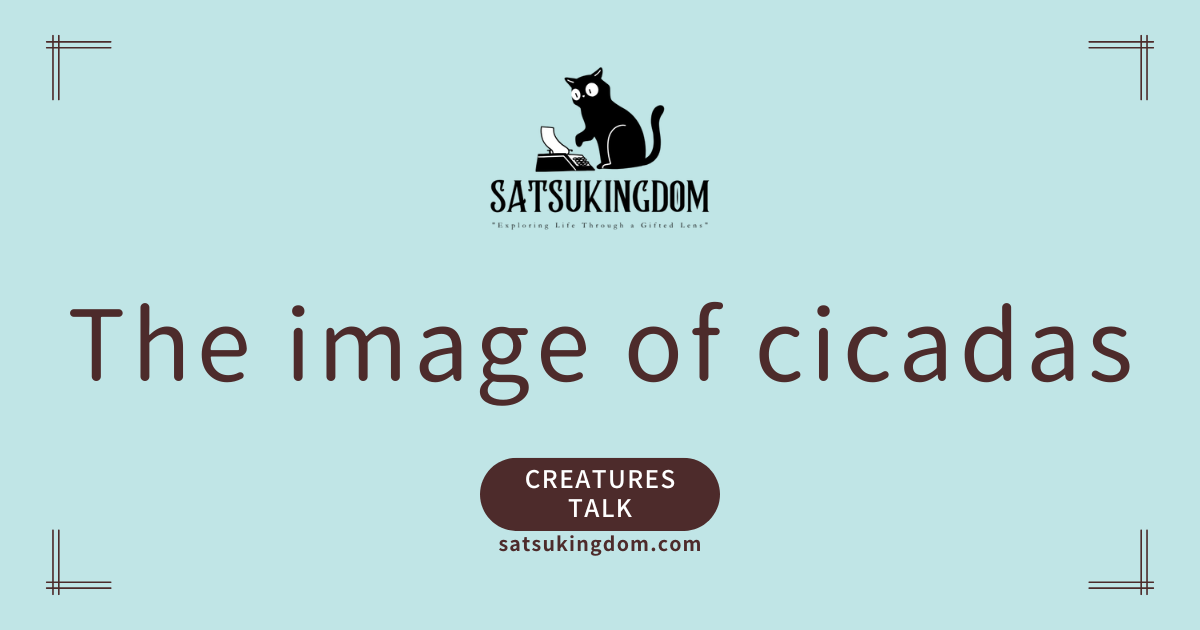This summer is hot again. Every year when I hear the cicadas chirping in summer, I think the same thing.
This time, please listen to my story. It might change your image of cicadas.
The life of a cicada is short.
As you all know, cicadas are said to have a lifespan of only about a week once they emerge from the ground. Having spent years underground and living for only a short time, they are sometimes regarded as a symbol of transience.
Mitsuyo Kakuta’s novel also bears the title The Eighth Day’s Cicada. It carries a metaphorical meaning: if a cicada were to survive beyond the eighth day, defying common sense and societal rules, that cicada could see a landscape no other cicada has ever witnessed. This impactful title, which links to many parts of the story, may be one reason the common belief that “cicadas die on the seventh day” became so widely accepted.
In reality, depending on the species, cicadas spend anywhere from two years to as long as 17 years underground. There, they grow up by sucking sap from tree roots. They spend this time repeatedly molting. After such a long period underground, even the longest-lived species spend only about a month above ground before their life ends. How fleeting.
Does it feel off?
Doesn’t this feel a bit off? I can’t help but feel uneasy about it every year. While the image of “cicadas = short lifespans” is firmly established, some species live for over ten years. At the very least, they live for several years.
I understand that “since the time above ground is short, it’s not wrong.” But that’s just humans arbitrarily deciding that “the significant part of a cicada’s life is above ground,” right? For the cicadas themselves, the time above ground might just be their “old age.” The joys of youth and middle age, as we humans know them, are underground. The underground is their life. As cicadas, they wouldn’t want to come above ground. They’d rather stay underground forever.
Couldn’t that be possible? I always wonder. If the cicada had just crawled out unsteadily and stayed quiet, maybe the image of a cicada’s life would have been different. Once it emerges from the ground, don’t you feel sorry for it?
If we speak of a short life, a fleeting life, it should be the mosquito, not the cicada. They hatch from eggs in just a few days, spend about a week as larvae, then go through a few days as pupae before becoming adults. The adult lifespan is only a few days for males and two weeks to a month for females. The time cicadas spend above ground is equivalent to a mosquito’s entire life. What’s more, humans use every trick in the book to target their lives. Very few mosquitoes get to live out their full lifespan. Well, poor things.
How different the treatment is, even though they’re the same insects.
Yes, I quibbled.
It’s all about image, isn’t it?
The cicadas are making such a racket—they must be thrilled to be out in the sky. Emerging from the dark, cold underground, they soar through the bright sunlight. It must be wonderful. But how fleeting that such a wonderful time ends after just a week or so. I understand.
And buzzing around people nonstop. They just keep coming, one after another. No matter how many times you swat them, they keep coming back for blood—damn persistent little pests! No matter how many precautions you take, no matter how tightly you shut the windows, where the hell do they keep coming from?
No wonder mosquitoes can’t compete with this image. They’re desperately trying to secure nutrients for their young, risking their lives to feed on blood. It’s said they only feed three to five times in their entire lives. Males live only a few days after completing their reproductive duties.
Images can be scary, huh?
When did this image start?
The image of the cicada’s fleeting life can be traced back to the Manyoshu. Poems using the word “utsusemi”—meaning the cicada’s shed shell—have been composed to express the transience of the world.
「utsusemino / yowatunenasito / shirumonowo / akikazesamumi / omoitsurukamo」
Yakamochi Otomo
【Knowing this world is fleeting, The autumn wind chills me— I remember you.】
This poem is included in Volume 3 of the Manyoshu and is said to have been composed in memory of the poet’s deceased wife. Even from this era, we glimpse a hint of the symbolism of transience. Here, the human body is likened to an empty shell, signifying that it is merely a temporary form in this world and fleeting—a concept slightly different from the cicada’s short and ephemeral life.
And the idea that “a cicada’s life lasts only seven days” is said to have originated in the Edo period. (※Various theories exist※) This belief arose because when people caught cicadas and kept them in cages, they often died quickly. It seems difficult to keep them alive long-term because recreating the environment where they feed on tree sap is challenging. Some of you might recall catching cicadas in elementary school only to have them die quickly, thinking, “Cicadas really have a short life.” Personally, I still can’t even touch cicadas, so I only remember hearing about this from friends.
Image is important
Even if I question and resist such a long-standing image, it’s not as if it can be changed so easily. That’s how important images are—they influence us, for better or worse. Even after the facts become clear, old preconceptions tend to prevail.
In our daily lives, we’re constantly swayed by all sorts of impressions. We should be careful not to judge the people and things around us based on our own arbitrary images.
This feeling comes back to me every year when I hear the cicadas sing.



コメント